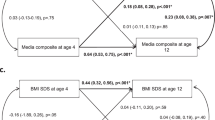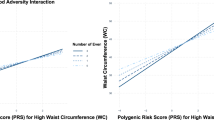Abstract
Background
There are few prospective studies of factors that mediate the association between exposure to adverse childhood experiences (ACEs) and obesity in adolescence. Our aim was to address this limitation.
Methods
We used prospective data from the Growing up in Ireland cohort study, with measurements at 9, 13, and 18 years old. The exposures were 14 adverse experiences before age 9. The main outcome was body mass index (BMI) at 18 years. Mediators were daily activity, diet quality, self-image and behavioural difficulties at 13 years.
Results
Among the 4561 adolescents in the final cohort, 77.2% experienced any adversity, 50.5% were female and 26.7% were overweight/obese at 18 years. BMI Z was higher at ages 9 (0.54 vs 0.43, p < 0.05, 95% CI of difference: −0.22, −0.01) and 13 years (0.50 vs 0.35, p < 0.05, 95% CI of difference: −0.25, −0.06), in those exposed to an ACE, compared to those unexposed. Structural equation models revealed that behavioural difficulties (β = 0.01; 95% CI: 0.007–0.018, p < 0.001) and self-concept (β = 0.0027; 95% CI: 0.0004–0.0050, p = 0.026) indirectly mediate the association between exposure to ACEs and BMI at 18 years.
Conclusions
The association between ACEs and BMI in adolescence is mediated by behavioural difficulties and self-concept.
Impact
-
In a previous study, we found modest associations between exposure to a range of adverse childhood experiences and weight gain at 13 years of age.
-
The strength of the association between adverse childhood experiences and weight gain was lower at 18 years of age compared to the association observed at 13 years and was no longer significant after controlling for confounding and including possible mediators.
-
The association between adverse childhood experiences and BMI in adolescence is indirectly mediated by behavioural difficulties and self-concept.
This is a preview of subscription content, access via your institution
Access options
Subscribe to this journal
Receive 14 print issues and online access
$259.00 per year
only $18.50 per issue
Buy this article
- Purchase on Springer Link
- Instant access to full article PDF
Prices may be subject to local taxes which are calculated during checkout



Similar content being viewed by others

Data availability
The datasets used for the current study are available from the Irish Social Science Data Archive: https://www.ucd.ie/issda/data/guichild/.
References
Rao, D. P., Kropac, E., Do, M. T., Roberts, K. C. & Jayaraman, G. C. Childhood overweight and obesity trends in Canada. Health Promot. Chronic Dis. Prev. Can. 36, 194–198 (2016).
Hannon, T. S. & Arslanian, S. A. Obesity in adolescents. N. Engl. J. Med. 389, 251–261 (2023).
Colditz, G. A. Economic costs of obesity and inactivity. Med. Sci. Sports Exerc. 31, S663–S667 (1999).
Avila, C. et al. An overview of links between obesity and mental health. Curr. Obes. Rep. 4, 303–310 (2015).
Jebeile, H., Kelly, A. S., O’Malley, G. & Baur, L. A. Obesity in children and adolescents: epidemiology, causes, assessment, and management. Lancet Diabetes Endocrinol. 10, 351–365 (2022).
Styne, D. M. et al. Pediatric obesity-assessment, treatment, and prevention: an Endocrine Society Clinical Practice Guideline. J. Clin. Endocrinol. Metab. 102, 709–757 (2017).
Hughes, K. et al. The effect of multiple adverse childhood experiences on health: a systematic review and meta-analysis. Lancet Public Health 2, e356–e366 (2017).
Danese, A. & Tan, M. Childhood maltreatment and obesity: systematic review and meta-analysis. Mol. Psychiatry 19, 544–554 (2014).
Schroeder, K., Schuler, B. R., Kobulsky, J. M. & Sarwer, D. B. The association between adverse childhood experiences and childhood obesity: a systematic review. Obes. Rev. 22, e13204 (2021).
Hemmingsson, E., Johansson, K. & Reynisdottir, S. Effects of childhood abuse on adult obesity: a systematic review and meta-analysis. Obes. Rev. 15, 882–893 (2014).
Wiss, D. A. & Brewerton, T. D. Adverse childhood experiences and adult obesity: a systematic review of plausible mechanisms and meta-analysis of cross-sectional studies. Physiol. Behav. 223, 112964 (2020).
Felitti, V. J. et al. Relationship of childhood abuse and household dysfunction to many of the leading causes of death in adults. The Adverse Childhood Experiences (ACE) Study. Am. J. Prev. Med. 14, 245–258 (1998).
Gardner, R., Feely, A., Layte, R., Williams, J. & McGavock, J. Adverse childhood experiences are associated with an increased risk of obesity in early adolescence: a population-based prospective cohort study. Pediatr. Res. 86, 522–528 (2019).
Cordola Hsu, A. R. et al. Adolescents’ depressive symptom experience mediates the impact of long-term exposure to maternal depression symptoms on adolescents’ body mass index. Ann. Behav. Med. 54, 510–517 (2020).
Davis, L., Barnes, A. J., Gross, A. C., Ryder, J. R. & Shlafer, R. J. Adverse childhood experiences and weight status among adolescents. J. Pediatr. 204, 71.e1–76.e1 (2019).
McKelvey, L. M., Saccente, J. E. & Swindle, T. M. Adverse childhood experiences in infancy and toddlerhood predict obesity and health outcomes in middle childhood. Child Obes. 15, 206–215 (2019).
Mendoza, I. D., Banda, J. A., Giano, Z. & Hubach, R. D. Association between adverse childhood experiences and fruit and vegetable intake among a national sample of U.S. adults. Prev. Med. Rep. 35, 102339 (2023).
Deng, K. & Lacey, R. E. Adverse childhood experiences, child poverty, and adiposity trajectories from childhood to adolescence: evidence from the Millennium Cohort Study. Int. J. Obes. 46, 1792–1800 (2022).
Edwards, V. J., Holden, G. W., Felitti, V. J. & Anda, R. F. Relationship between multiple forms of childhood maltreatment and adult mental health in community respondents: results from the Adverse Childhood Experiences Study. Am. J. Psychiatry 160, 1453–1460 (2003).
Diedrick, M., Clements-Nolle, K., Anderson, M. & Yang, W. Adverse childhood experiences and clustering of high-risk behaviors among high school students: a cross-sectional study. Public Health 221, 39–45 (2023).
Lewis-de Los Angeles, W. W. Association between adverse childhood experiences and diet, exercise, and sleep in pre-adolescents. Acad. Pediatr. 22, 1281–1286 (2022).
Russell-Mayhew, S., McVey, G., Bardick, A. & Ireland, A. Mental health, wellness, and childhood overweight/obesity. J. Obes. 2012, 281801 (2012).
Rankin, J. et al. Psychological consequences of childhood obesity: psychiatric comorbidity and prevention. Adolesc. Health Med. Ther. 7, 125–146 (2016).
Lindberg, L., Hagman, E., Danielsson, P., Marcus, C. & Persson, M. Anxiety and depression in children and adolescents with obesity: a nationwide study in Sweden. BMC Med. 18, 30 (2020).
Murray, A. et al. The Growing up in Ireland Cohort: Design, Instrumentation and Procedures for the Child Cohort (Economic Social Research Institute, 2010).
Murphy, D., Williams, J., Murray, A. & Smyth, E. The Growing up in Ireland: Design, Instrumentation and Procedures for Cohort ‘98 at 17/18 Years of Age (Economic Social Research Institute, 2019).
Dube, S. R. et al. Childhood abuse, household dysfunction, and the risk of attempted suicide throughout the life span: findings from the Adverse Childhood Experiences Study. JAMA 286, 3089–3096 (2001).
Statistics Canada and Human Resources Development Canada. National Longitudinal Survey of Children: Overview of Survey Instruments for 1994–1995, Data Collection, Cycle 1 (Government of Canada, 1995).
Rodd, C., Metzger, D. L., Sharma, A. & Canadian Pediatric Endocrine Group (CPEG) Working Committee for National Growth Charts. Extending World Health Organization weight-for-age reference curves to older children. BMC Pediatr. 14, 32 (2014).
de Onis, M. et al. Development of a WHO growth reference for school-aged children and adolescents. Bull. World Health Organ. 85, 660–667 (2007).
Goodman, R. Psychometric properties of the Strengths and Difficulties Questionnaire. J. Am. Acad. Child Adolesc. Psychiatry 40, 1337–1345 (2001).
Goodman, R. The Strengths and Difficulties Questionnaire: a research note. J. Child Psychol. Psychiatry 38, 581–586 (1997).
Flahive, M. H., Chuang, Y. C. & Li, C. M. The multimedia Piers-Harris Children’s Self-Concept Scale 2: its psychometric properties, equivalence with the paper-and-pencil version, and respondent preferences. PLoS ONE 10, e0135386 (2015).
Wang, Y. & Beydoun, M. A. The obesity epidemic in the United States-gender, age, socioeconomic, racial/ethnic, and geographic characteristics: a systematic review and meta-regression analysis. Epidemiol. Rev. 29, 6–28 (2007).
Dixon, B., Pena, M. M. & Taveras, E. M. Lifecourse approach to racial/ethnic disparities in childhood obesity. Adv. Nutr. 3, 73–82 (2012).
Ardic, C., Usta, O., Omar, E., Yildiz, C. & Memis, E. Effects of infant feeding practices and maternal characteristics on early childhood obesity. Arch. Argent. Pediatr. 117, 26–33 (2019).
Perry, C. P. et al. The use of a dietary quality score as a predictor of childhood overweight and obesity. BMC Public Health 15, 581 (2015).
Hu, L. T. & Bentler, P. M. Cutoff criteria for fit indexes in covariance structure analysis: conventional criteria versus new alternatives. Struct. Equ. Modeling 6, 1–55 (1999).
Pearl, J. The causal mediation formula-a guide to the assessment of pathways and mechanisms. Prev. Sci. 13, 426–436 (2012).
Roseell, Y. Lavaan: an R package for structural equation modeling. J. Stat. Softw. 48, 1–36 (2012).
Howe, L. D., Tilling, K. & Lawlor, D. A. Studying the life course health consequences of childhood adversity: challenges and opportunities. Circulation 131, 1645–1647 (2015).
Keeshin, B. R. et al. Sexual abuse is associated with obese children and adolescents admitted for psychiatric hospitalization. J. Pediatr. 163, 154.e1–159.e1 (2013).
Pinhas-Hamiel, O., Modan-Moses, D., Herman-Raz, M. & Reichman, B. Obesity in girls and penetrative sexual abuse in childhood. Acta Paediatr. 98, 144–147 (2009).
Isohookana, R., Marttunen, M., Hakko, H., Riipinen, P. & Riala, K. The impact of adverse childhood experiences on obesity and unhealthy weight control behaviors among adolescents. Compr. Psychiatry 71, 17–24 (2016).
Shenk, C. E., Noll, J. G., Peugh, J. L., Griffin, A. M. & Bensman, H. E. Contamination in the prospective study of child maltreatment and female adolescent health. J. Pediatr. Psychol. 41, 37–45 (2016).
Acknowledgements
We are indebted to the families who participated in the Growing Up in Ireland Cohort study and the staff at the Economic and Social Research Institute in Dublin for data collection and management.
Funding
Growing Up in Ireland was commissioned by the Irish Government and funded by the Department of Health and Children through the Office of the Minister for Children (OMC) in association with the Department of Social and Family Affairs and the Central Statistics Office. These analyses were funded through a grant awarded to J.M. from the Canadian Institutes of Health Research. J.M. holds a Applied Public Health Chair in Resilience and Obesity in Youth awarded by the Canadian Institutes of Health Research and the Public Health Agency of Canada. This work was also supported by Canadian Institutes of Health Research (CPP-137910), Department of Children and Youth Affairs (DCYA), and Republic of Ireland.
Author information
Authors and Affiliations
Contributions
J.M. devised the original proposal, secured funding for the analyses, and had overall responsibility for the study. H.S.D.V. helped develop the original proposal, was involved in the analysis of data, and drafted the manuscript. B.D. was responsible for data analysis and data interpretation. All authors contributed to data interpretation, reviewed and contributed to drafts of the manuscript, and approved the final report.
Corresponding author
Ethics declarations
Competing interests
The authors declare no competing interests.
Consent statement
All stages of the Growing Up in Ireland project were approved by the Health Research Board’s standing Research Ethics Committee based in Dublin, Ireland and these analyses were approved by the Biomedical Research Ethics Board at the University of Manitoba.
Additional information
Publisher’s note Springer Nature remains neutral with regard to jurisdictional claims in published maps and institutional affiliations.
Supplementary information
Rights and permissions
Springer Nature or its licensor (e.g. a society or other partner) holds exclusive rights to this article under a publishing agreement with the author(s) or other rightsholder(s); author self-archiving of the accepted manuscript version of this article is solely governed by the terms of such publishing agreement and applicable law.
About this article
Cite this article
De Visser, H.S., Dufault, B., Brunton N, N. et al. Early life adversity and obesity risk in adolescence: a 9-year population-based prospective cohort study. Pediatr Res (2024). https://doi.org/10.1038/s41390-024-03040-7
Received:
Revised:
Accepted:
Published:
DOI: https://doi.org/10.1038/s41390-024-03040-7


